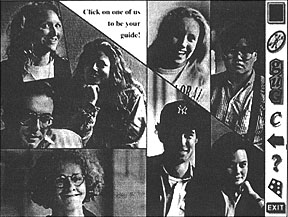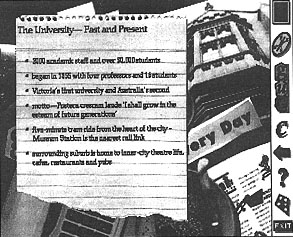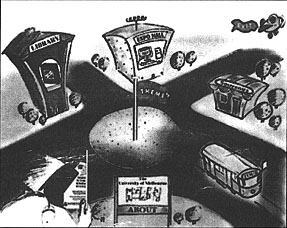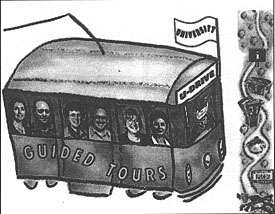
 |
As Kristina Hooper Woolsey (1988) states:
Anyone who has looked at run of the mill computer software or branching videodiscs that continually interrupt the viewer with multitudes of unappealing choices understands that interactivity is not a sufficient condition for a good experience. Similarly, those of us who have sat on the edge of our seats in lecture halls and theaters, enjoying a non passive experience even though we have no control over outcomes or opportunity for any interaction, must acknowledge that there is really something to the crafts of rhetoric and storytelling. (p.320)Very often it is the skill of the designer that guarantees its interactivity, whether that technology be a book, a lecture, a video, or a CD-ROM. Interactivity is not necessarily inherent in the technology itself.
Multimedia marketers would have us believe that the ability to point and click is a far more interactive experience than the ability to turn pages in a book. Books do not have to be, and in fact often never have been, only used for linear presentation. They, like multimedia, can provide information in chunks and provide the reader with the ability to navigate in any direction - via the contents page and an index. If the book as a format was not such a wondrous thing, then why do so many interactive multimedia developers imitate the book as an interface metaphor?
This is not to say that the older technologies are perfect. Design of hypermedia systems can lead to improvements in the design of older technologies. Ted Nelson's Xanadu system was an early hypertext system, pre-dating HyperCard by over ten years. His book, Computer Lib: Dream Machine, challenged the format of the traditional print medium twenty years ago.
Another example is Apple's book Demystifying Multimedia (1993). This book uses bold to imply links as does any hypermedia document, but instead of being able to click the bold to go to that link, the page numbers of the link are in brackets after the bold. The book is also organised so that each page is a chunk in its own right, and can be read in whichever order takes the reader's fancy, or in which order the reader has need , more like a magazine than a textbook.
We need to be clear as to what we mean by the word 'interactive'. It is being promulgated as a necessary condition of an effective learning environment. However, interactivity goes beyond mere point and click. An analysis of the different types of interactive experience is provided in a previous paper "Beyond browsing: Making interactive multimedia interactive" (Wills, 1994). It may variously mean: simple electronic page turning, hierarchical menu choices, point and click browsing systems, or testing and tutoring on black and white facts. However it could more aptly describe active environments that engage the learner in a challenge or mission based on manipulating the information contained in the system. Interaction may be better defined as engagement.
Two products I've designed utilise guides as a technique (Figures 1 & 4), University of Melbourne Interactive Handbook and Interactive Proceedings for an IFIP Working Conference at University of Melbourne in 1994, Interactive Multimedia In University Education: Designing for Change in Teaching and Learning (Beattie, McNaught & Wills).
In 1993 we set out to design an interactive version of The University of Melbourne's Undergraduate Handbook Volume 1. The 60 page colour handbook is distributed to prospective students and contains information about the university and its courses. The design team treated the task as building a graphical user interface on top of the 30,000 words of descriptive prose in the handbook.

Figure 1: Interactive Handbook - Guides Interface
One solution to the problem of providing interesting navigation through 30,000 words of prose was to humanise the handbook by providing eight university students from a range of courses and backgrounds to act as young guides to the university (Figure 1). Audio grabs from the guides give insight to university life from their personal perspective and add humour to what was probably a dry publication. The guides offer pathways into areas that the interactor might not otherwise have explored.
Oren et al (1992) used guides for a similar purpose with an American history database prototyped at Apple in 1989:
It has been widely noted that hypertext systems are characterised by user disorientation, or "getting lost" while attempting to find a way among the myriad connected documents and links... The hypertext author's purpose may be to provide an educational experience, but the cognitive load posed by navigating among the various items may be so great that the user has little energy left for absorbing the content... We began looking at the use of characters and the human figure to suggest a story like structure and get the user involved in a search for relationships among the various pieces of information ... Guides first appeared in the form of travel agents ... [Then] we decided to change the interface so that it... all looked like part of the historical period. We wanted to add visual richness, provide a context, and seduce users into the mood of the database from the start. (pp.367-371)They then researched how best to represent the guides: as icons, as cartoon figures, or as photographs/video using actors. They observed interesting differences in users' reactions, noting that even with iconic guides, users assumed characterisation although the designers had not explicitly set out to develop them as characters.
We have found value in the deliberate personification of the interface, in introducing the conventions of storytelling, point of view, and character into the computing milieu. This seems to result in engagement, projection, and suspension of disbelief on the part of the users. Children often assume educational material is objective and comprehensive, but in fact any encyclopedia has a particular perspective... Guides suggest a natural way to present multiple voices and points of view (p.376-377).In creating guides for the Interactive Handbook, we chose an alternative not available to the historical database designers - we used real people. Schools Liaison Officers often remark that students are our best sales vehicle. The implications that follow from the design choice of real students versus invented graphical characters include the need to
The University of Wollongong Education Faculty's Exploring River Nardoo, a soon to be released ecological simulation, following the success of Investigating Lake Iluka, makes excellent use of guides. The guides are an interesting hybrid of video actors and hand drawn graphics.
Guides as a technique in the Interactive Handbook was well received and achieved the goal of taking the interactors into parts of university life that they might not have otherwise seen. However one of the evaluating students said in their thinking aloud video: it is an unfulfilled promise - it raises our expectations and fails to deliver". They wanted a conversation with the guides! The design team feel that the CD-ROM needs additional features to enhance its interactivity, for example, an adventure game or puzzle to solve; interviews with graduates; and video clips of the university experience such as lectures, tutorials, field trips, laboratories, and the social scene.
The capability to personalise information and humanise the interface with guides is something well handled by interactive multimedia and not as well handled by books. However, this doesn't mean that books cannot do it. The printed handbook went part way in reflecting our approach - it provides a snapshot and thumbnail interview with each of the same students.

Figure 2: Dot points replace paragraphs of prose in version 2
Our multimedia publication hadn't replaced the existing print based handbook. Text is very well served by print technology. In hindsight, the multimedia publication has to serve a different purpose from the print based handbook.
Menu choices in the Interactive Handbook structure reflected the print based handbook structure therefore the publication did not address aspects of university life that multimedia capacities could have dealt with if we had designed the content from scratch rather than rooting it in the existing delivery format.
The process of designing, evaluating and reflecting on the nature of the Interactive Handbook has forced a rethink of the function and format of the traditional handbook, and other University promotional products such as videos, in recognition that each medium has unique characteristics that could be better harnessed to complement each other rather than compete.
Oren et al noted similar concerns with their historical database:
... in designing an interface to a textual database, we have found that the writing style adapted to the print medium is not optimal for the computing medium. This is a warning that there may be sharp limits to the notion of "re-purposing"; that is, moving existing content to a new medium by simple format conversion... Because the text base was fixed, expanding the guide's role in the video version required adding content in the video sequences. The result is that the richness of the video image currently dominates the user's experience. The text appears flat and boring in comparison. (p.378)
An aim in deciding to design an interactive proceedings for the IFIP conference was to bring closer together the conference process and the conference outcome. The team set out to produce an experience for the interactor that reflects the interactive nature of such conferences; to capture the atmosphere and the progressive development of the debate and discussion; to enable the interactor to see and hear the personality of the authors via video and audio.
Editors of conference proceedings in general take one of two routes for organising the print based proceedings: alphabetical order of authors or an order that reflects the conference timetable. An interactive proceedings allows the interactor to approach the papers from multiple angles not just those structured by the editors. In this Interactive Proceedings, multiple perspectives are provided via the Theme Roundabout, the Guided Tours, the Expo Hall, the Souvenir Stand and the Library (figure 3). Hypermedia links provide alternative perspectives not usually possible in a print based proceedings other than via a comprehensive index.

Figure 3: Main menu of Interactive Proceedings : Map interface
The Theme Roundabout is a means for authors to position their papers against each of the three conference themes (Design, Implementation, Evaluation) whereas the conference timetable allows positioning only under one theme dictated by the program chair.
The Expo Hall was designed to contain most multimedia demonstrations used at the conference. This feature is a quantum leap on print based proceedings, which merely talk about multimedia instead of doing multimedia. The Expo Hall allows review and reflection on demonstrations that went all too fast in the confines of a conference timetable. Print might be a good medium for discussing multimedia but it is a poor medium for demonstrating multimedia.
The Library houses the traditional papers in alphabetical order of author (as does the print based proceedings) and provides fast scrolling, hypermedia links, and audio comment from each author.
The Souvenir Stand supplies major elements of conferencing that are missing from print based proceedings: networking and touristing. It contains informal snapshots of the conference including social events; business cards; home video of Melbourne sights; and postcards.
The officially designated conference Reflectors and selected conference participants recorded Guided Tours while at the conference (figure 4) to reflect and link aspects of the papers that were important from their personal or institutional perspective. For the interactor, these Guided Tours provide comments from discussion sessions and links to papers via audio and video clips recorded live at the conference.
There is also a facility ("U-Drive") for the interactor to record their own tour using the presentation maker which bookmarks their selection of screens and attaches their voice comments. Like marginal scribbles in a print based proceedings, this "U-Drive" facility enables the interactor to tailor a multimedia report of the proceedings. Tools such as these, which allow the interactor to construct, manipulate and add value to pre-prepared published content, provide higher levels of interactivity than a print based proceedings.
Another aspect of the product design is the flavour and style of the graphics and interface. Part of attending any conference is the humour, repartee and social events. It is not just the academic content that one remembers but the interaction with people. Traditional print based proceedings are stuck in a formula that do not reflect that atmosphere of friendliness. It was our aim to produce an interface with humour - it should make you smile.
Did we succeed with our interface techniques for interactive multimedia? Not entirely. As Brian Harvey says in his guided tour in the Interactive Proceedings:
So-called interactive multimedia makes a promise it cannot keep. The interaction is very far from being a conversation. We experts get to do the talking while you users get to choose which expert to listen to.

Figure 4: Interactive Proceedings : Guide interface
Conference proceedings are now being published on the network, in fact many assume that the web is all we need now. AUSWEB95 is an excellent example of a multiplatform proceedings - it's on the web, in print, and on CD-ROM. So is OZCHI95. Teleteaching 96, a virtual conference later this year, will only publish on the web and CD-ROM, bypassing print altogether.
However we still have much thinking to do about the value of each platform, about reassessing the role and best features of each technology, and using them appropriately. Currently they are too closely tied, copying each other in form and content. The learning need, or information need, is not likely to be best addressed by a sole technology, nor is it cost effective to publish on all platforms. A combination of appropriate technologies seems more sensible - "multimedia" in the original use of the word as multiple forms of media.
As the bandwidth of networks increases, the capacity to publish multimedia conference proceedings, and university handbooks, will become the norm. The powerful combination of multimedia publishing and network publishing will be a paradigm shift in conferencing and publishing. The technologies are there, but do we yet understand the techniques for guaranteeing the interactor a truly interactive experience?
Apple Computer (1993). Demystifying Multimedia. Cupertino: Apple.
Nelson, T. (1987). Computer Lib: Dream Machine (2nd ed). Microsoft Press.
Oren, T., Salomon, G., Kreitmam, K. & Don, A. (1992) Guides: Characterising the interface. In Laurel, B. (Ed), The Art of Human-Computer Interface Design, 367-382. Menlo Park: Addison-Wesley.
Wills, S. (1994). Beyond browsing: Making interactive multimedia interactive. In Rethinking the Role of Education in the Technological Age, EdTech94 Conference, Singapore May 1994, 58-68.
Wills, S. & Swart, R. (1994). The Book is Dead: Long Live the Book. In Beattie, K., McNaught, C. & Wills, S. (Eds), Interactive Multimedia in University Education: Designing for Change in Teaching and Learning. Amsterdam: North-Holland, pp. 83-92.
| Author: Assoc Prof Sandra Wills Director Educational Media Services University of Wollongong Northfields Ave, Wollongong NSW 2522, Australia Ph: 042 214 544 Fax: 042 258 312 Email: s.wills@uow.edu.au Please cite as: Wills, S. (1996). Interface to interactivity: Technologies and techniques. In C. McBeath and R. Atkinson (Eds), Proceedings of the Third International Interactive Multimedia Symposium, 50-55. Perth, Western Australia, 21-25 January. Promaco Conventions. http://www.aset.org.au/confs/iims/1996/ry/wills.html |